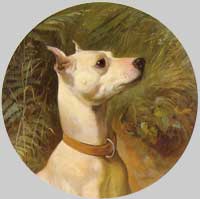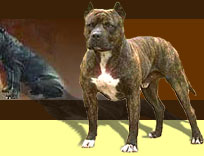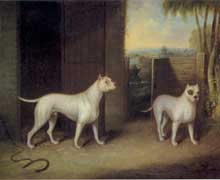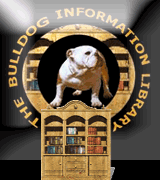Staffordshire
Bull Terrier

What's the difference between an American Pit Bull Terrier (APBT), an American Staffordshire Terrier and a Staffordshire Bull Terrier ?
The three most similar of the Bully Breeds differ in the following points:
1. Bone structure:
The the front legs are more robust in structure in the Amstaff and Staffordshire Terrier, while in the Pit Bull the drive (pushing power) and agility in the hind legs is more emphasized.
2. Size:
The Staffordshire is the smallest, while the American Pit Bull Terrier is the largest and heaviest of the three. However, the APBT breed also shows a wider variation in size than the Staffordshire Bull Terrier and American Staffordshire Terrier. The early lines of APBT were smaller and even today some breeders still prefer the smaller APBT, so size is not a decisive factor.
3. Coat Color:
In the American Pit Bull Terrier any color or color pattern is acceptable, except for merle. In the Amstaff brindle is the most diffused, but there is no preference scale or order of priority for the other colors. Black & tan (hereditary of the ancient black & tan terrier), liver color (transmitted by the ancient pit bulls) and white (if more than 80%) are not desirable in the Amstaff and Stafford.
4. Ears:
The American Staffordshire Terrier and American Pit Bull Terrier are usually exhibited with cropped ears. The Stafford's ears are never cropped and should be "rose" (like those of an English Bulldog) or half-pricked.
5. Head:
The heads of American Staffordshire Terriers, American Pit Bull Terriers and Staffordshire Bull Terriers are similar, although the cheek on most Staffords seem to be more more prominent, and the head deeper through.

All Bull and Terrier breeds descend from similar but seperate varieties of "Bull-and-Terriers" produced from crosses between different types of British Terriers (White English Terrier, Manchester Terrier) and ancient Bulldogs.
History
The American Pit Bull Terrier descends from dogs imported at the end of the 1800's and beginning of the 1900's by the English, Scottish and Irish immigrants.
Upon arrival in the US they were crossbred to become larger and taller producing offspring that resembled more the ancient bulldog (or molossian) type leaving people wondering today why they are being called "Terriers". The terrier suffix should simply be considered as a relic of their remote ancestors (the ancient "Bull-and-Terriers"), not as an indication of these dogs' classification, type or genetic make-up (they are not "half terrier, half bull" as is sometimes assumed). These dogs and their descendants were often known under names that referred to their breeds or place of origin (staffordshire bull terrier, half-and-half or blue paul terrier, the now-extinct Scottish version of the English Bull Terrier), or to their function (pit bull terrier). Later on new names were coined (American pit bull, American bull terrier, Yankee terrier, Yankee bull terrier).
These dogs were utilized for guard work, protection, hunting and dog fighting, more like the old-type bulldog or molossians, never for ground work like the terriers. When used for dog fighting, these dogs were referred to as "pit bulls" independently of their origin or morphological type. The concept of "dog breeds" is relatively recent and was not in use until the advent of the first dog clubs and dog shows at the end of the 1800's. Before that, dogs were categorized according to their function, not their morphological traits. Early classifications include "types" like hunting dogs, mastiffs, lapdogs, retrievers, water dogs, bull dogs, etc. all referring to a job description, not a "breed". As a result, selective breeding was based on performance, never on looks or confirmation to a "standard". For example, any dog that did the work of a bull dog and was good at it, WAS a bulldog, independently of his looks.


White English Terrier Ch. Prince c. 1870
Colour plate by George Earl
Photo courtesy: William Secord
The offspring of these dogs were originally bred for dog-fighting and combined the muscle power, tenacity and high pain threshold of the Bulldog with the alertness and agility of the Terrier.
In the same way "pit bulls" referred to dogs used for staged dog fifths, i.e. to a function, not to a breed of dogs.
It should be noted here that the use of "pit" in the sense of "set (cocks, dogs, etc.) to fight for sport" is first recorded in 1760, making it doubtful that the name "pit bull" was ever used before that date. Still today pit bulls as referred to by the public or in pit bull bans do not usually or exclusively refer to the pit bull (as recognized by the UKC) but can affect any such breeds as the American Staffordshire Terrier, Staffordshire Bull Terrier, Bull Terrier, Miniature Bull Terrier, Bandogs, Pit Bullmastiffs or genetically modified and ill-bred pit bull mongrels.
Of course certain types of dogs were better at specific types of work and selective breeding was aimed at reinforcing those morphological traits that facilitated the dog's job.
Distinct types of Bull-and-Terrier strains developed. The smaller, stockier, Stafford "working class" strain was baptized as Staffordshire bull terrier in 1935, after their county of origin, and has remained nearly unmodified.
In some regions of the US the imported "pit bulls" were selectively bred for increased height and weight to further improve their performance. When dog fighting was outlawed fanciers of this "sport" in the Boston area found they needed a smaller breed that could be more easily hidden under one's coat at the arrival of the police. The local "bull-and-terrier" fighting dogs were dwarfed down, probably using the french bulldog, leading to the "round-headed Bull and Terrier" the ancestor of today's Boston Terrier. The smaller versions were also often used as ratters in the cramped housing conditions in which the immigrants lived in the emerging industrial cities.
The name Bull Terrier had been previously registered in the late 1800's for a more refined strain of elegant white dogs developed by James Hinks.
While the American Staffordshire Terrier was recognized in 1936 by the AKC some breeders continued to register their dogs with the UKC and the ADBA.
Still today some fanciers of these dogs consider the American Pit Bull Terrier the working type and the Amstaff the show type of one and the same breed.
However, as we explained before, as the concepts of "type" and "function" predate that of "breed" it is more correct to refer to two different "breeds" when referring to today's dogs, now that both breeds are actually recognized as such. The Staffie, Amstaff and Pit Bull differ not only in size, but also in color preferences. At the same time it can't be denied that the Amstaff and Pit Bull's history are very closely related and that specimens of either breed and even Staffies can be occasionally mistaken for one another, especially when their ears are not cropped (the ears of the Staffie are never cropped !)
From 1898 on, when the United Kennel Club (UKC) was founded by American Pit Bull fanciers, cross-breeding was no longer accepted for the dogs born on American soil.
In the following years the UKC started registering other breeds and APBT breeders decided to found the American Dog Breeders Association in 1909 that solely registered American Pit Bull Terriers.
Some breeders wanted to distance themselves from the American Pit Bull Terrier due to the dog fighting connotation attached to the name and sought to register their lines of dogs under a different name. They first tried to register the breed with the American Kennel Club in 1930 under the name American bull terrier, but encountered heavy opposition by the Bull Terrier Club of America. The next attempt initiated by William Judy, editor of Dog World magazine, who suggested to change the name into Yankee terrier, was equally fruitless. Finally, after the recognition of the Staffordshire Bull Terrier by the English Kennel Club, the AKC registered the breed in 1936 under the name Staffordshire terrier. In 1972 the name was eventually changed into American Staffordshire Terrier.
The dogs that were used in the fighting pits were also used as family dogs. So, they had to demonstrate a loyal and friendly character, on top of their ability to fight.
© by C. Marien-de Luca for Bulldog Information 2003-2011.
.
.
.
.
The
Canine Information Library and
Dogbreeds.bulldoginformation.com 2003-2011 © All rights reserved.
Original idea, design and development by C. Marien-de Luca. No part of bulldoginformation.com may be copied, distributed, printed or reproduced on another website without the owner's written permission. Please feel free to link from your site to any of the pages on this website in a non-frame presentation only.
An Owner's Guide to Raising
Your Pet Protector
by Lori Berg, Michael ''Gypsy'' Stratten
More information:
Irish
Staffordshire
Bull Terrier
early Bull-and-Terrier crosses c. 1830
Photo courtesy: William Secord
The American Pit Bull Terrier Handbook
(Barron's Pet Handbooks)
by Joe Stahlkuppe
The American Staffordshire Terrier :
Gamester and Guardian
(Howell's Best of Breed Library)
by Sarah Foster

































